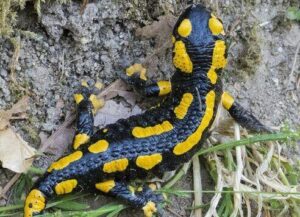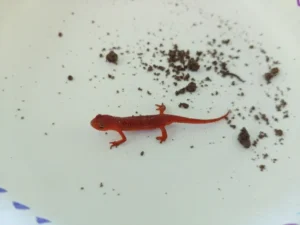Salamanders are secretive amphibians that hide in cool, moist places under rocks or logs. They move slowly and stay quiet, which means many people never see them in the wild. But when someone does come across one, they often wonder: are salamanders poisonous to eat?
Most salamanders are not good to eat. Their skin contains toxins that can make you sick or even kill you. While they have been eaten in some cultures, doing so is considered unsafe and highly discouraged.
Why Are Salamanders Poisonous?
Salamanders do not have claws or sharp teeth. They are not fast or strong. Instead, they rely on their skin to defend themselves from predators.

Many species have special glands that produce toxins. These chemicals taste bad, irritate the mouth, and can damage the digestive system. Some can even stop the heart or nervous system.
This defense makes animals think twice before taking a bite. It also protects the salamander without the need for a fight.
Which Salamanders Are the Most Toxic?
Not all salamanders are equally dangerous, but some carry powerful poisons that should not be taken lightly.
Rough-skinned Newt (Taricha granulosa)
This newt lives in the Pacific Northwest. It contains tetrodotoxin, the same poison found in pufferfish. Just a small amount can block nerve signals and stop breathing.

Eating one is extremely risky. There are rare cases of human deaths caused by consuming this newt.
Fire Salamander (Salamandra salamandra)
Found in parts of Europe, this salamander releases a toxin called samandarin. It causes muscle spasms, high blood pressure, and convulsions.

Its bright yellow markings serve as a warning. They signal that this is not a safe meal.
Eastern Newt (Red Eft Stage)
Adult eastern newts are only mildly poisonous, but the bright orange juvenile is very highly toxic. Even more than the adult, it releases strong toxins that protect it from being eaten.

Its color helps predators remember: one taste is enough.
What Happens If You Eat One?
Eating a salamander can lead to serious symptoms. These can appear quickly and become life-threatening if not treated.
Common signs include:
- Nausea or vomiting
- Tingling or numbness in the face or limbs
- Difficulty breathing
- Tremors or seizures
- Paralysis or heart failure
Even cooking won’t always help. Some toxins are heat-stable and stay active even after boiling or frying.
This is not exotic food. It’s a medical emergency.
Are Salamanders Ever Used as Food?
In modern times, salamanders are not used for food. Most people know that many are poisonous and stay away from them.
However, there are historical accounts of salamanders being eaten. In some cases, they were used in traditional medicine or consumed during famines.
In parts of China and Japan, giant salamanders have sometimes been harvested. These practices are controversial and often illegal.
Today, eating salamanders is considered unsafe and unethical.
Are Any Species Safe to Eat?
There is no salamander that is truly safe to eat. Even those with mild toxins can still make you sick.
They can cause allergic reactions or upset your stomach. Their bodies were never meant for human digestion.
If you are foraging for food in the wild, skip salamanders. Stick to known edible species like fish or certain types of frogs.
Why Are Their Toxins So Strong?
Salamanders are easy to catch. Their small size and slow speed make them vulnerable to birds, snakes, and mammals.
To survive, they developed powerful chemical defenses. A strong toxin means predators are less likely to try again.

Some of these toxins are so strong, they rival the defenses of snakes or sea creatures.
When you can’t outrun your enemy, you have to outsmart them. For salamanders, poison is the answer.
Do Any Animals Eat Them?
Yes, but only a few.
Some predators have adapted to resist their toxins. One of the most notable is the garter snake. In some areas, garter snakes can eat even the rough-skinned newt.
This has led to what scientists call an evolutionary arms race. As newts become more toxic, snakes become more resistant.
Research on tetrodotoxin resistance in salamanders shows how the ongoing struggle between predator and prey has shaped them over time.
Other predators might try once, get sick, and learn never to do it again.
Can Touching One Make You Sick?
Touching a salamander is not the same as eating one, but it can still be risky.
If you touch a toxic species and then rub your eyes, lips, or a cut, you might feel a burning sensation or numbness.
Always wash your hands after handling any wild animal. That helps protect both you and the salamander.
Never lick your fingers or put your hands in your mouth after contact.
What If a Pet Eats One?
Dogs and cats are often curious. If they bite or eat a salamander, they can get sick quickly.
Watch for these signs:
- Drooling or vomiting
- Trembling or weakness
- Trouble walking or standing
- Seizures
Call your vet immediately if you notice symptoms. Salamander toxins can act fast.
To stay safe, keep your pets away from wild amphibians altogether.
Why the Confusion?
Salamanders look like small lizards or frogs. Some people may confuse them with edible animals, especially in regions where frogs are eaten.
But frogs and salamanders are very different. Frogs used for food are prepared carefully to remove harmful parts.
Salamanders contain dangerous chemicals throughout their bodies. There is no safe way to cook or clean them for eating.
Their shiny skin and bright colors are a warning, not an invitation.
Are There Laws Against Eating Them?
Yes, in many places it is illegal to collect, harm, or eat wild salamanders.
Many species are protected because their populations are declining.
Eating one could violate conservation laws, even if it doesn’t make you sick.
Protecting salamanders is important for the health of their ecosystems.
Can Their Toxins Be Used for Medicine?
Some scientists are studying salamander toxins for medical use. Scientists are studying tetrodotoxin as a possible way to block pain, helped by new tools that make it easier to detect and understand the toxin.
Other studies focus on their ability to regrow limbs and organs. Salamanders are full of medical potential.
But none of this means you should eat one. The research happens in labs, not kitchens.
Their poisons may help people one day, but only under controlled conditions.
Do People Still Eat Them Today?
In most places, no. Salamanders are not part of modern diets.
Some reports from rural areas suggest they are eaten in rare cases, usually during times of scarcity. These practices are becoming less common as awareness grows.
Modern food safety guidelines strongly warn against eating any amphibians that are not specifically raised for food.
Salamanders do not meet that standard.
What If Someone Eats One by Accident?
If someone eats a salamander, call emergency services right away. Don’t wait for symptoms to appear.
Keep the person calm and avoid giving food or drink. Medical help is needed to manage the effects.
Try to identify the species, if possible. That can help doctors choose the right treatment.
The CDC lists tetrodotoxin as a very powerful poison that needs quick medical care if someone is exposed.
Fast action can save a life.
What About Cooking or Drying Them?
Cooking or drying a salamander may reduce surface bacteria, but it won’t remove the toxins.
Many salamander poisons are heat-resistant. That means even boiled or fried salamander can be dangerous.
Traditional drying methods also fail to make them safe. The toxins remain in the tissues and skin.
The risks are just too high.
Are There Any Myths About Eating Salamanders?
Yes, folklore in some cultures has claimed that salamanders can make you immune to fire or heal disease.
These stories are myths. There is no truth to them, and eating a salamander for magical reasons is just as dangerous.
Science has replaced superstition, and we now understand the real risks.
Admire salamanders for their beauty and biology, not for their place in legends.
Conclusion
Are salamanders poisonous to eat?
Yes, salamanders contain toxins that can cause serious illness or death if consumed.
These chemicals evolved to protect them from predators, and they are not destroyed by cooking.
There are no safe species of salamanders for food. They are not part of modern diets and should never be eaten.
Even touching one requires care, and handling them can be harmful to the salamander.
Hi, my name is Ezra Mushala, i have been interested animals all my life. I am the main author and editor here at snakeinformer.com.

